by Keith Kellett
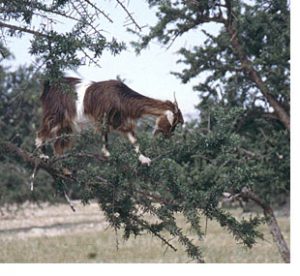 Agadir was once a principal fishing port in southern Morocco until it was totally destroyed in a disastrous earthquake in 1960. It’s since been completely rebuilt on a new site and, although the fishing port has been retained, it’s now, first and foremost, a resort town.
Agadir was once a principal fishing port in southern Morocco until it was totally destroyed in a disastrous earthquake in 1960. It’s since been completely rebuilt on a new site and, although the fishing port has been retained, it’s now, first and foremost, a resort town.
Most of the architecture is a pleasing kind of ‘Hollywood-Moorish’, its white buildings contrasting to the inland towns and villages, which are usually a terra-cotta colour.
There’s a long sweep of beach, and the climate is usually pleasantly warm rather than oppressively hot. There’s night-life for those who want it; those who don’t can easily avoid it.
But, frequently, I heard ‘Agadir isn’t the real Morocco!’, and if you tire of shopping, or sitting around the beach or swimming pool, you’ll realise Agadir’s disadvantage. It’s so far from anywhere else! Exploring the ‘real Morocco’ is usually only achieved by means of a bum-numbing coach ride. But, your bum gets just as numb on a sun-lounger! So why not?
We found that many tour companies operating in Agadir offered coach tours to various destinations … and we didn’t need to be ‘travelling with’ those companies in order to book one. We only had to find the appropriate ‘rep’ to make a booking.
This is a much better idea than booking a ‘package’ at home before leaving. There are better ways of spending a holiday than being cooped up with a busload of compatriots but, at least, this way, you aren’t stuck with the same crowd day after day.
Marrakech is a favourite destination for the coaches. Once, it was on the hippy trail, and even today it’s a magnet for backpackers. But, it’s 300 kilometres from Agadir, which means either an overnight stop or an extremely early start.
However, Taroudante sometimes markets itself as ‘Little Marrakech’ and that’s only about a third of the distance from Agadir. The comparison is easy to see; both are walled cities where the dominant colour is terra-cotta and both have busy markets. It lacks Marrakech’s Jemaa al Fnaa square, and its almost perpetual display of ‘world music’ and other performing arts … but it also lacks the performers allowing you to pick your own pocket in return for photographing them!
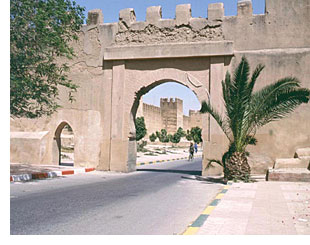 A charming Irish lass from one of the tour companies called at our hotel, and sold us a tour to Taroudante, which would also call at the Tioute oasis, where we would have a traditional Bedouin lunch at the Kasbah.
A charming Irish lass from one of the tour companies called at our hotel, and sold us a tour to Taroudante, which would also call at the Tioute oasis, where we would have a traditional Bedouin lunch at the Kasbah.
Contrary to what Hollywood used to have us believe, the Kasbah isn’t a mysterious part of the city where foreigners proceed at their peril … it’s simply a citadel or a fortification, and most towns, even villages, have one.
The Kasbah at Tioute is perched on a hill-top, overlooking the oasis and the village, and does look rather like a cross between Castle Dracula and Fort Zinderneuf … but, inside, it’s a pleasant, modern restaurant. The food, however, is traditional.
The Moroccan national dish is tagine. That’s usually lamb or chicken, stewed with olives in deep earthenware dish with a conical lid, also called a tagine. We were four at table; Lorraine my wife, a husband and wife writer/photographer partnership we met on the bus, and myself.
We shared a tagine between us, which we ate Berber style, using pieces of bread instead of cutlery … and earning looks of absolute horror from the two old ladies at the next table.
Meanwhile, a young man named Mohammed presented himself, and said that when we’d finished our meal, he would conduct us down the hill, and show us around the oasis.
At the foot of the hill, villagers with donkeys awaited those who didn’t wish to walk. Lorraine took a donkey, as she hadn’t quite recovered from an ankle injury. I remembered the flea I picked up last time I rode a donkey, and walked.
On the way to the oasis, Mohammed told us he had two jobs. When not working as a guide, he helped his grandfather in his ‘garden’. Maybe that’s the right word … at Tioute, it’s hard to see where the garden ends and the orchard begins; where the orchard ends and the farm begins. They all sort of segue together.
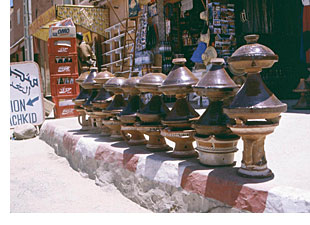 Of course, in an oasis, the important thing is the water, and Mohammed proudly showed us the clean, clear watercourse irrigating his grandfather’s ‘garden’. Some of us just couldn’t resist taking a mouthful of the sweet water … to the horror of the two old ladies, who were resolutely lugging around plastic bottles of water which, by this time, were warm enough to make tea with!
Of course, in an oasis, the important thing is the water, and Mohammed proudly showed us the clean, clear watercourse irrigating his grandfather’s ‘garden’. Some of us just couldn’t resist taking a mouthful of the sweet water … to the horror of the two old ladies, who were resolutely lugging around plastic bottles of water which, by this time, were warm enough to make tea with!
The main crop around Tioute is the argan tree. It grows nowhere else but southern Morocco and a small area in Mexico. A valuable oil is extracted from its fruit, which Moroccans say is essential for cooking tagine properly.
Just outside Tioute, we were surprised to find goats happily grazing in the branches of the argan trees, leaping nimbly from branch to branch. They find argan leaves irresistible, and have no difficulty in climbing on the low branches to get at them.
Achmet, the bus driver, said that sometimes, the goat-boys lift the goats into the trees, in order to request money from anyone stopping to photograph them. He said this deceit is easily detected, because these goats are standing still, not moving about and grazing.
On the way to Taroudante, we saw more goats in trees, not only standing still, but all facing in the same direction. ‘Good Muslim goats!’ observed Achmet. ‘They all face Mecca, and pray to God to get them out of the tree safely!’
About the author:
Traveling Tales welcomes writer/photographer Keith Kellett who makes his home in England.
Photos by Keith Kellett:
1: The goats outside Tioute browse the argan trees for their succulent leaves
2: The ochure-coloured walled city of Taroudante is sometimes known as ‘Little Marrakech’
3: The conical earthenware tangine stew pots on sale at Taroudante
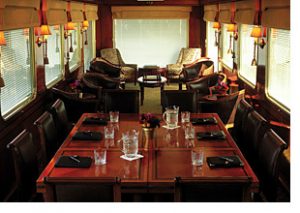
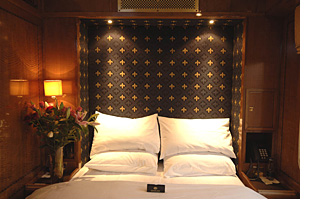 The luxurious accommodation features the finest bed linen, marble tiles and gold fittings in spacious bathrooms and the overall ambience of sheer opulence and sophistication will have you rarely wanting to leave your stateroom.
The luxurious accommodation features the finest bed linen, marble tiles and gold fittings in spacious bathrooms and the overall ambience of sheer opulence and sophistication will have you rarely wanting to leave your stateroom.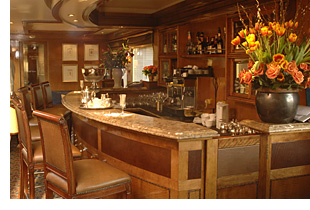 The Main Lounge car is perfect for lazy afternoon teas while the Club Car, where television sets show a driver’s-eye view of the ever-changing landscape ahead, is popular for post-dinner cognac and a Cuban cigar. The poker players will love the Gentleman’s club ambience where the gentle illumination from antique lamps takes you straight into the set of a Casablanca-like epic, where everyone could be an eloping couple, a spy or a vagabond.
The Main Lounge car is perfect for lazy afternoon teas while the Club Car, where television sets show a driver’s-eye view of the ever-changing landscape ahead, is popular for post-dinner cognac and a Cuban cigar. The poker players will love the Gentleman’s club ambience where the gentle illumination from antique lamps takes you straight into the set of a Casablanca-like epic, where everyone could be an eloping couple, a spy or a vagabond.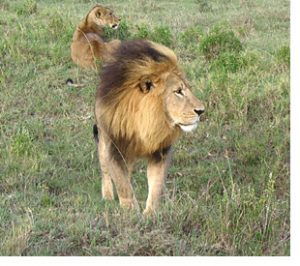
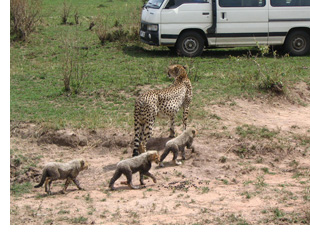 When we came across a mother cheetah and her six fur-ball cubs, Joseph’s eyes took on an effulgence of admiration. “They can reach speeds of 105 km and hour,” he said, “They’re particular about what they eat, preferring smaller game like antelope. Their kill is dragged up into tree branches where they eat it slowly instead of gorging.”
When we came across a mother cheetah and her six fur-ball cubs, Joseph’s eyes took on an effulgence of admiration. “They can reach speeds of 105 km and hour,” he said, “They’re particular about what they eat, preferring smaller game like antelope. Their kill is dragged up into tree branches where they eat it slowly instead of gorging.”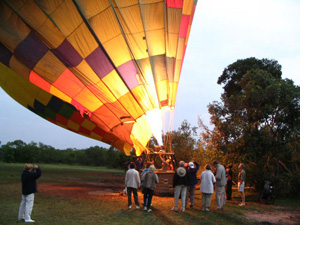 On the last day we splurged. A military jeep transported us to a 5-star resort to join a balloon safari. We stood by as hot air brought the limp balloon to life.
On the last day we splurged. A military jeep transported us to a 5-star resort to join a balloon safari. We stood by as hot air brought the limp balloon to life.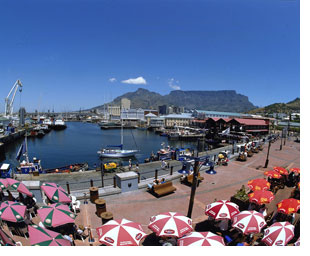 It was called the Cape of Storms by early Dutch settlers, whose ships floundered in turbulent seas on the jagged rocks surrounding the southern-most tip of Africa.
It was called the Cape of Storms by early Dutch settlers, whose ships floundered in turbulent seas on the jagged rocks surrounding the southern-most tip of Africa. Me, I prefer to escape the rush of traffic when in Cape Town, and experience the city’s beauty on one of its many hiking trails that weave their way into the mountains. Traversing the uppermost reaches of the city, these peaceful, un-crowded pathways lead visitors past some of Africa’s magnificent flora, fauna and bird-life as well as offering spectacular ocean vistas.
Me, I prefer to escape the rush of traffic when in Cape Town, and experience the city’s beauty on one of its many hiking trails that weave their way into the mountains. Traversing the uppermost reaches of the city, these peaceful, un-crowded pathways lead visitors past some of Africa’s magnificent flora, fauna and bird-life as well as offering spectacular ocean vistas.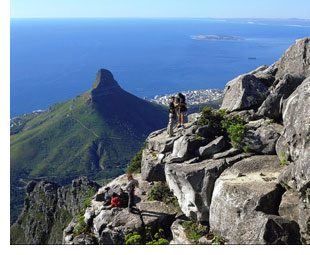 Robben Island, once a maximum security prison for political activists during the apartheid years, is a national monument and museum today. Tours (which include a 40-minute boat trip from the harbour) are conducted by former inmates, who teach visitors about the harsh conditions of prison life they endured here.
Robben Island, once a maximum security prison for political activists during the apartheid years, is a national monument and museum today. Tours (which include a 40-minute boat trip from the harbour) are conducted by former inmates, who teach visitors about the harsh conditions of prison life they endured here.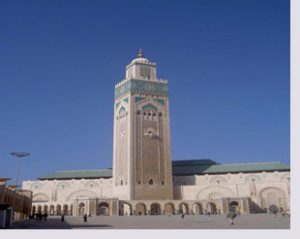
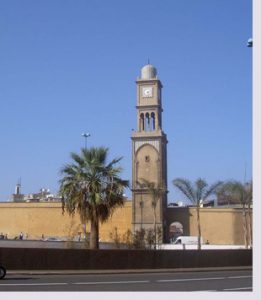 In 1921, the French who were ruling Morocco at that time, built a new medina called Al Habous, making Casablanca the only city in the country besides the old, has a new medina built along traditional lines. At the same time, the harbour was expanded until eventually it became the largest port in Africa. National and international businesses set up offices in the city and an impressive expansion, which has never slowed down, was put into motion, creating a huge metropolis, bursting at the seams.
In 1921, the French who were ruling Morocco at that time, built a new medina called Al Habous, making Casablanca the only city in the country besides the old, has a new medina built along traditional lines. At the same time, the harbour was expanded until eventually it became the largest port in Africa. National and international businesses set up offices in the city and an impressive expansion, which has never slowed down, was put into motion, creating a huge metropolis, bursting at the seams.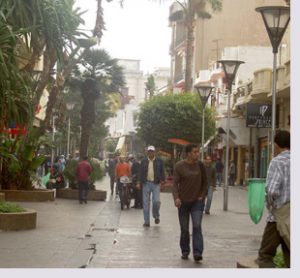 If one is seeking fun and relaxation, past Hassan’s Mosque is the Corniche with its fine beaches. The heart of the area is Ain Diab, crowded with hotels, sidewalk cafes, nightclubs and excellent restaurants where travellers can linger over tasty meals in dream-like settings.
If one is seeking fun and relaxation, past Hassan’s Mosque is the Corniche with its fine beaches. The heart of the area is Ain Diab, crowded with hotels, sidewalk cafes, nightclubs and excellent restaurants where travellers can linger over tasty meals in dream-like settings.
 We were high in Morocco’s Atlas Mountains, surrounded by Berbers and beautiful, but inhospitable country. “Take off your jewelry, leave your wallets with the driver; and don’t leave my side.” Our instructions were more like orders and for one uneasy moment, as my husband and I exchanged nervous glances, we wondered if this was how neophytes were seconded into white slavery. But we really wanted to explore this extraordinary market and if this was the price, we were prepared to obey. After all, our escorts were ‘official guides’ and with that stature, our safety as tourists was more than their own lives were worth.
We were high in Morocco’s Atlas Mountains, surrounded by Berbers and beautiful, but inhospitable country. “Take off your jewelry, leave your wallets with the driver; and don’t leave my side.” Our instructions were more like orders and for one uneasy moment, as my husband and I exchanged nervous glances, we wondered if this was how neophytes were seconded into white slavery. But we really wanted to explore this extraordinary market and if this was the price, we were prepared to obey. After all, our escorts were ‘official guides’ and with that stature, our safety as tourists was more than their own lives were worth. A two-hour drive from tourist-oriented Marrakesh, the tiny market village of Asni is barely visible on the map yet come Saturday, it is one of the busiest Berber souqs (markets) you will find. While these markets are generally safe, foreigners still represent easy pickings to many stall-keepers and traders. In city centers, the King has installed undercover ‘tourist police’ to mingle with the crowds and haul away overly zealous hawkers. Consequently, souvenir shopping is fairly hassle free, save for the odd bartering session. But here in the mountains, royal edicts are less easily enforced so it was with common-sense wisdom that we secured an escort.
A two-hour drive from tourist-oriented Marrakesh, the tiny market village of Asni is barely visible on the map yet come Saturday, it is one of the busiest Berber souqs (markets) you will find. While these markets are generally safe, foreigners still represent easy pickings to many stall-keepers and traders. In city centers, the King has installed undercover ‘tourist police’ to mingle with the crowds and haul away overly zealous hawkers. Consequently, souvenir shopping is fairly hassle free, save for the odd bartering session. But here in the mountains, royal edicts are less easily enforced so it was with common-sense wisdom that we secured an escort. As with many traditional markets, fresh meat and produce are the order of the day and soon, we were walking down a path lined, like some satanic trail, with the just-skinned heads of sheep. It led to the open air abattoir where Berbers were feverishly haggling over the plumpness of chickens, entrails and very fresh lamb. This market is not for the squeamish.
As with many traditional markets, fresh meat and produce are the order of the day and soon, we were walking down a path lined, like some satanic trail, with the just-skinned heads of sheep. It led to the open air abattoir where Berbers were feverishly haggling over the plumpness of chickens, entrails and very fresh lamb. This market is not for the squeamish. For many of these mountain folk, getting their goods to market is almost day’s hike, clambering beside lush valleys and through the crumbly terra cotta mountains that resemble millefeuilles of loose strata. With them come hundreds of mules, each piled high with loads so heavy, they leave a legacy of sway backs, sores and split hooves. Once at market, these forlorn-looking creatures are herded into a corral and, rather like readying a car for road, the animals were fed, watered, and shod. On-the-spot blacksmiths tend the line while first aid ‘mechanics’ wrap grubby cloths around bleeding hooves, readying the animal for the return trek.
For many of these mountain folk, getting their goods to market is almost day’s hike, clambering beside lush valleys and through the crumbly terra cotta mountains that resemble millefeuilles of loose strata. With them come hundreds of mules, each piled high with loads so heavy, they leave a legacy of sway backs, sores and split hooves. Once at market, these forlorn-looking creatures are herded into a corral and, rather like readying a car for road, the animals were fed, watered, and shod. On-the-spot blacksmiths tend the line while first aid ‘mechanics’ wrap grubby cloths around bleeding hooves, readying the animal for the return trek. We took our cue and readied ourselves for the drive back to Marrakesh. Of all our travels in Morocco, this had been among the most authentic. As a working market, Asni offered an insight into a way of life that seems frozen in time. Only the merchandise changes so that today, old Nike running shoes have found retail value alongside kitchen utensils carved out of bone. And while take-home souvenirs were virtually non existent, Asni offers something more – a travel experience that stirs curiosity and captures the imagination for years to come.
We took our cue and readied ourselves for the drive back to Marrakesh. Of all our travels in Morocco, this had been among the most authentic. As a working market, Asni offered an insight into a way of life that seems frozen in time. Only the merchandise changes so that today, old Nike running shoes have found retail value alongside kitchen utensils carved out of bone. And while take-home souvenirs were virtually non existent, Asni offers something more – a travel experience that stirs curiosity and captures the imagination for years to come.